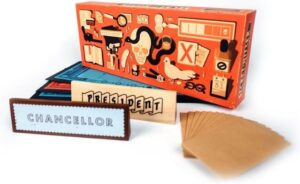Ah yes, the noble dream: a weekly board game night with your favorite people, full of laughter, betrayal, and mild shouting over rules disputes. You’ve seen the TikToks, the Instagram reels—groups of quirky friends battling for cardboard supremacy while sipping obscure sodas and debating whether “house rules” are valid law or heresy.
But then you try it yourself… and it fizzles faster than a New Year’s gym membership. People bail. The vibe is weird. Someone brings Risk and ruins everyone’s life. Again.
This guide exists to make sure that doesn’t happen. Whether you’re a tabletop veteran or just trying to lure your friends off their phones for an evening, we’ll show you exactly how to start a game night—and more importantly, keep it from crashing by week three.
Step 1: Assemble the Right Group
This isn’t The Avengers. You don’t need a tank, a healer, and a rogue. But you do need a few people who are:
- Willing to show up more than once
- Cool with losing (or at least pretend to be)
- Not allergic to cardboard or basic human interaction
The sweet spot is 4–6 people. Enough for most games, not so many that it turns into a scheduling nightmare or a full-on HOA meeting.
Step 2: Pick a Recurring Time
“We’ll find a time that works for everyone” is a lie. Set a recurring day and time—say, every Thursday at 7pm—and let people self-select whether they’re in or out. This does three things:
- Removes the endless group chat scheduling vortex
- Builds a rhythm so it becomes part of people’s week
- Lets flakes be flakes without tanking the whole group
Pro tip: It’s fine if only 3 people show up sometimes. Just play something that works for a smaller crew (more on that below).
Step 3: Start with the Right Games (Read: Not Monopoly)
This is where a lot of groups implode. You don’t have to go full-Eurogamer right out the gate, but for the love of all that is holy, please skip the dusty classics that end in rage or boredom.
Here’s a no-fail starter menu based on group size and vibe:
For 3–4 Players:
- Azul – Pretty, puzzly, and secretly cutthroat.
- Wingspan – Beautiful bird engine builder. Yes, really.
- Splendor – Easy to learn, hard to master. Like socializing.
For 5+ Players:
- Codenames – Word game magic. Best with snacks.
- Just One – Cooperative, hilarious, and impossible to mess up.
- Decrypto – Like Codenames, but with more paranoia.
For Chaos Gremlins:
- Secret Hitler – Lies, alliances, and yelling.
- Blood on the Clocktower – If your group likes werewolves and has time to commit.
(Psst: Some of those might have affiliate links soon. Just sayin’.)
Step 4: Rotate Hosts (Unless One Person Has the Board Game Batcave)
If one person has the setup—big table, good lighting, a dog that won’t eat components—it’s fine to always host there. But otherwise? Rotate. It keeps things fair, prevents burnout, and gives everyone a chance to show off their snack game.
Use a simple rotation system. Alphabetical by first name. Dice roll. Winner of last game picks the next host. Whatever works. Just make sure it’s not always falling on the one friend who owns napkins.
Step 5: Use (Reasonable) House Rules and Clarify Before You Start
Nothing kills momentum faster than a 45-minute rules debate. Decide up front: are you playing by official rules, or are you allowing “house flavor” like free parking bonuses or custom roles?
House rules are fine—if everyone agrees. Just don’t blindside a newbie mid-game by yelling “That’s not how we do it!” like some cardboard cultist.
Step 6: Snacks Are the Lifeblood of Game Night
Look, nobody’s coming for the rulebook. They’re coming for the vibes, and the vibes are 60% snacks. A few guidelines:
- No greasy fingers. No Cheetos. You are not an animal.
- BYOS: Bring Your Own Snacks works great for rotating hosts.
- Level up: Themed snacks. Yes, they’re extra. No, we don’t care.
If you’re the host, consider keeping a stash of dry, safe snacks like pretzels, cookies, or popcorn. Bonus points for napkins and coasters.
Step 7: Handle the Flake Factor Without Rage Quitting
Someone will bail. Every week, probably. Don’t cancel the whole night. Just play something that works with fewer people. That’s why it’s smart to build a group flexible enough to absorb a few absences.
If it’s always the same person? Have a low-key convo. Or quietly stop inviting them. Your call. You’re an adult (probably).
Step 8: Document the Chaos
Take photos. Share ridiculous quotes in the group chat. Keep a running scoreboard of who wins the most (or who rage quits the most). This turns game night into a story, not just a meeting.
You’ll be shocked how quickly these memories stack up—and how much people look forward to reliving them.
Step 9: Mix It Up, But Not Too Much
Once you have momentum, rotate in new games gradually. Too much change too fast and people get overwhelmed. (Yes, even Janet. Especially Janet.)
A good rule of thumb: 80% familiar, 20% new. That keeps things fresh without overwhelming people who barely learned what “engine builder” means.
Step 10: Don’t Be a Rules Lawyer
Yes, you technically can only build one settlement per turn. No, you don’t need to slam the rulebook down like you’re defending a dissertation. Let the table vote if something’s unclear. Or let it slide and fix it next round.
The goal is fun. Not filing a lawsuit over sheep trades.
Last Tip: Stick With It for a Month Before You Judge
Most groups take 3–4 sessions to really click. Expect awkward silences. Expect one or two duds. Stick with it anyway. By week four, people are trash-talking, strategizing, and showing up early.
And once that happens? You’ve got something rare: a real, sustainable board game night that people actually look forward to. And maybe even shower for.






0 Comments